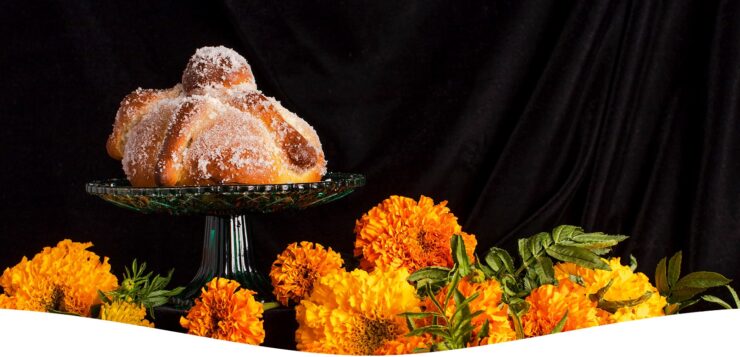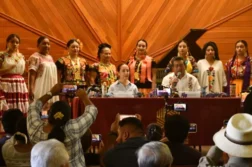Bakers of the holiday bread use secret family recipes, creating over 900 versions of it across Mexico
In October, pan de muerto — bread of the dead — starts showing up in panaderías (bakeries) and market stalls all across Mexico. Although it’s an integral part of the ofrendas — offerings made on altars in homes and atop graves in cemeteries during Day of the Dead ceremonies on November 1 and 2 — it’s so good, it’s consumed by the living as soon as it appears.
The origins of Day of the Dead stretch back millennia, with roots in pre-Hispanic Nahua civilizations, which include the Mexica (Aztecs), Toltecs, Xochimilca and Acolhua. For them, death was seen as a natural part of life, and the dead were still considered part of the community.
During specific times, they believed, the dead were able to return to the earth briefly. That belief continues to this day across Mexico.
Rather than being feared, the departed are welcomed and offered the food, drink and music they enjoyed in life. Although the ceremonies differ from region to region, there’s one constant: pan de muerto, a sweet yeast bread.
Francisco García Castillo and Verónica Avana Trejo, a husband-and-wife team, start making their pan de muerto in early October and can be found working in their panadería in Chipilo, Puebla, a little past dawn every day. The bread they make is one that’s the most familiar in Mexico: it has a round base that represents a skull and two strips across the top that are shaped to look like bones.

The recipe they use, said García, is special. “This recipe is only used for pan de muerto,” he explained while mixing the ingredients for the dough. “It is exclusive for that.”
Avana asked that I not reveal the exact recipe, but she did point out the most important ingredient: a flavoring called esencia naranja oleosa — an orange flavored oil. “This flavoring is important for pan de muerto,” she said. “If there is no flavoring, it is not pan de muerto. It is the essence of pan de muerto.”
García sits on a stool and watches intently as the ingredients are mixed in an industrial machine. At various times, he removes a small sample and rolls it in his hands. “When the dough does not stick to my hands, it is ready,” he said.
Once it is, it’s set on a worktable and left to rise. When García determines that the dough is high enough, he cuts it into small sections and rolls it into little balls. Nearby, Avana mixes the dough that they will use to make the bones. García pats the balls flat with his hand and then places the bones on top.
Although the couple’s breads are all the same shape, the ones they sell have three different flavors: ajojonolí is sprinkled with sesame seeds before baking. The azucar flavor is slathered with melted butter after baking and then rolled in a generous amount of sugar. A third one contains the chocolate and hazelnut spread Nutella.
To make that one, García puts a generous spoonful of Nutella into a dozen of the unbaked rolls and then covers them with melted butter and sugar after baking. “Nutella,” he said, “is the most popular. It is something that is more or less only done in Puebla, although it is also popular in Mexico City.”
He then bakes the bread at 180 C for 13 minutes. The rolls emerge from the oven a lovely golden brown.
Interestingly, García said that he once tried making the bread in June but didn’t like the results. “The flavor was not the same,” he said. “It changed a lot. I used the same recipe, no changes. I think the difference is the time of year. This time of year, the flavor is much better.”
There are reportedly more than 900 versions of pan de muerto found across the country.
Eva Chapa sells three versions in San Gregorio Atlapulco, a pueblo in the Xochimilco borough of Mexico City, where she’s had a stand at the local market for over 20 years. She uses recipes handed down through her family for generations, ones she regards as special. “They are only used for pan de muerto,” she said. “Each family has its own recipe.”
In addition to a pan de muerto that’s the same shape as the ones sold by García and Avana, Chapa sells two other versions of the bread. The golletes looks like a large donut and is covered with sugar that is dyed red.
“The gollete symbolizes the skulls of Aztec sacrificial victims,” said Javier Márquez Juárez, who has extensively studied pre-Hispanic cultures. “The hole in the middle represents the hole in skulls through which a stick was placed before they were hung on a wall called a tzompantli, which was located in the Templo Mayor [in what is now Mexico City]. The red sugar represents their blood.”

A third variety Chapa offers is called alamar. It’s pretzel-shaped and, according to Márquez, made to look like the designs found on the traditional clothing of a charro, a Mexican cowboy.
In addition to differences in the recipes and shapes for pan de muerto, there are other regional differences.
The Tecalo family panadería, also located in San Gregorio Atlapulco, is a popular choice for buying pan de muerto and is incredibly busy in October. Although there’s no way to tell how many breads they’ll eventually churn out, they do know that they use almost 4,400 pounds of flour and 20,000 eggs to make their bread.
Like other panaderías, they use a unique family recipe. “I learned how to make it from my grandparents,” said Imelda Tecalco Sandoval.
They also use a special flour. “We do not use this flour for other breads,” said Ludwig Tecalco. “It has a different flavor.” Customers can request their bread to be made with different ingredients like pecans, raisins or almonds.
While the majority of panaderías, especially those in cities, now use gas ovens — which are more easily regulated — ones in smaller, more indigenous pueblos often don’t. “We use wood in the stove because it is more traditional,” said Violeta Guzmán, who works in her small, family-run panadería in Santa Ana Tlacotenco, in the Milpa Alta borough of Mexico City. “Also, it gives the bread a better flavor.”
Agustín Melo, whose panadería is also in Santa Ana Tlacotenco, bakes very traditionally. He uses a recipe he learned from his grandparents, makes his pan de muerto with flour he doesn’t use for any other breads or pastries and bakes it in a wood-fired oven.
Like all the other bakers interviewed for this article, his bread will only be available until November 1 and won’t reappear until next October.
When asked why, he said simply: “It is because we respect the traditions of our ancestors.”
Joseph Sorrentino, a writer, photographer and author of the book San Gregorio Atlapulco: Cosmvisiones and of Stinky Island Tales: Some Stories from an Italian-American Childhood, is a regular contributor to Mexico News Daily. More examples of his photographs and links to other articles may be found at www.sorrentinophotography.com He currently lives in Chipilo, Puebla.





